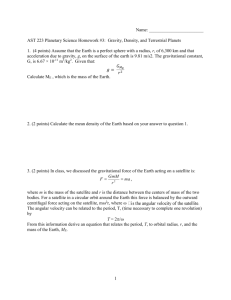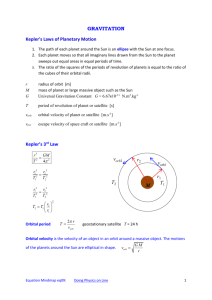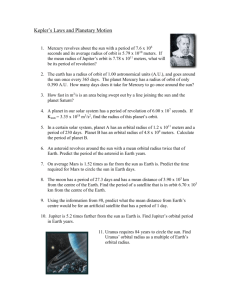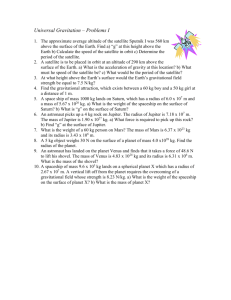take home test: due 12/2/13!!!!! no late tests.
advertisement
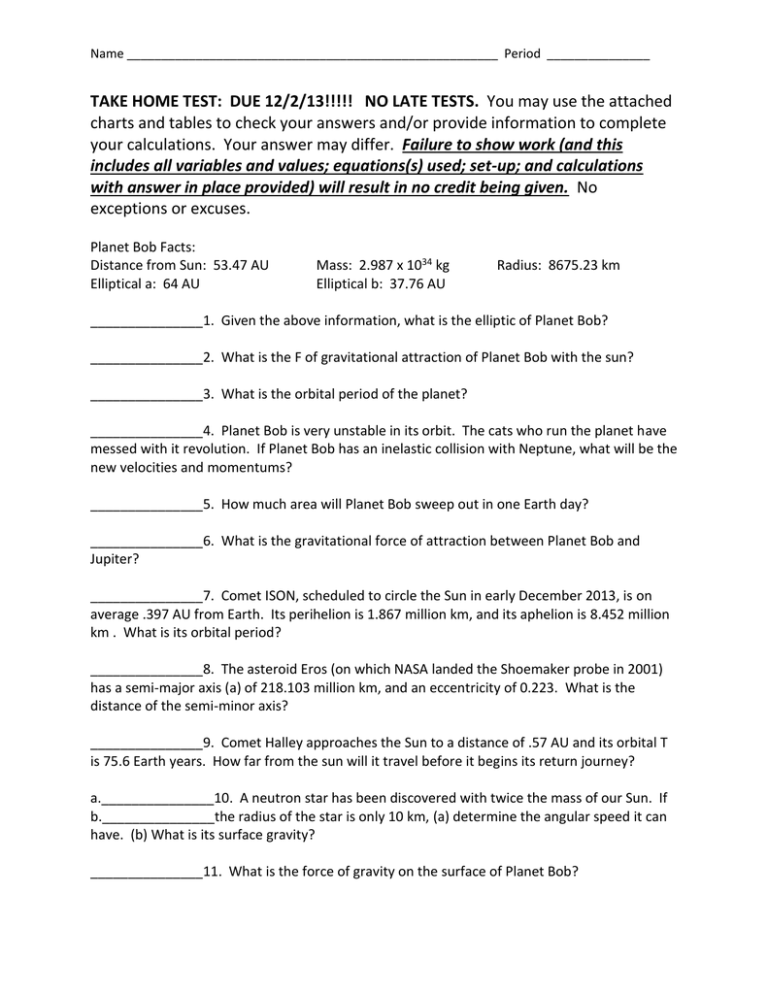
Name ______________________________________________________ Period _______________ TAKE HOME TEST: DUE 12/2/13!!!!! NO LATE TESTS. You may use the attached charts and tables to check your answers and/or provide information to complete your calculations. Your answer may differ. Failure to show work (and this includes all variables and values; equations(s) used; set-up; and calculations with answer in place provided) will result in no credit being given. No exceptions or excuses. Planet Bob Facts: Distance from Sun: 53.47 AU Elliptical a: 64 AU Mass: 2.987 x 1034 kg Elliptical b: 37.76 AU Radius: 8675.23 km _______________1. Given the above information, what is the elliptic of Planet Bob? _______________2. What is the F of gravitational attraction of Planet Bob with the sun? _______________3. What is the orbital period of the planet? _______________4. Planet Bob is very unstable in its orbit. The cats who run the planet have messed with it revolution. If Planet Bob has an inelastic collision with Neptune, what will be the new velocities and momentums? _______________5. How much area will Planet Bob sweep out in one Earth day? _______________6. What is the gravitational force of attraction between Planet Bob and Jupiter? _______________7. Comet ISON, scheduled to circle the Sun in early December 2013, is on average .397 AU from Earth. Its perihelion is 1.867 million km, and its aphelion is 8.452 million km . What is its orbital period? _______________8. The asteroid Eros (on which NASA landed the Shoemaker probe in 2001) has a semi-major axis (a) of 218.103 million km, and an eccentricity of 0.223. What is the distance of the semi-minor axis? _______________9. Comet Halley approaches the Sun to a distance of .57 AU and its orbital T is 75.6 Earth years. How far from the sun will it travel before it begins its return journey? a._______________10. A neutron star has been discovered with twice the mass of our Sun. If b._______________the radius of the star is only 10 km, (a) determine the angular speed it can have. (b) What is its surface gravity? _______________11. What is the force of gravity on the surface of Planet Bob? Name ______________________________________________________ Period _______________ _______________12. The force of gravitation attraction between Mars (6.4 x 10 23kg) and its moon Phobos (9.6 x 1015 kg) is 4.6 x 1015 N. How far apart are the two objects? _______________13. A new planet if found that is 14 AU from the sun. Use Kepler’s Third Law to predict the orbital period if K = 2.97 x 10-19 s2/m3. _______________14. Use Kepler’s Third Law to find the orbital period (in days) of Mars. Remember – Earth is used as a baseline. (FYI – the orbit of Mars is 1.52 times greater than Earth’s) _______________15. The Kepler Constant of Planet Bob’s moon, Hazle, is 5.6 x 10 26 m3/s2. What is Hazle’s mass? _______________16. If Planet Sabyn (she took over control of a planet), orbits in a radius of 1.5 x 1011 m around a sun with a mass of 2 x 1030 kg, what is its orbital speed? a._______________17. NASA launches a 5000 kg satellite to orbit Mars (m = 6.37 x 10 23 kg) at a b. _______________ v = 2000 m/s. Find the (a) orbital radius, (b) period and (c) centripetal c. _______________ force acting on the satellite. _______________18. A planet’s mean distance from the Sun is 5 x 1012 m. What is its T? _______________19. If an object weighs 200 N on the surface of the Earth, what will it weigh at 9 x 105 m above the surface? _______________20. What would the weight of the same object be if it were 1500 km below the Earth’s surface? _______________21. A satellite orbiting Earth has a period of 50 days. What is its altitude above the Earth? _______________22. With what speed does Jupiter orbit the sun? Use 2 x 10 30 kg for masssun and Jupiter orbit radius as 7.78 x 1011 m. _______________23. The period of the Earth’s moon is 27.3 days and has a mean orbital radius of 3.8 x 105 km. Earth’s r = 6380 km. What is the radius of a satellite if it orbits in 14 days? (Hint: T2/R3 = T2/R3) _______________24. The gravitational field intensity at the surface of a moon is 3.4 N/kg. If the mass of Hazle is 7.2 x 1022 kg, what is its radius? _______________25. If the mass of Titan is 1.35 x 1023 kg and its r = 2570 km, what is the force of gravity at its surface on a 500 kg probe? Name ______________________________________________________ Period _______________ _______________26. Calculate the KE of a 1249 kg satellite circling around earth with a total radius of 13740 km. a._______________27. Assume a satellite with a mass of 1537 kg falls to earth from 1000 km. b._______________What velocity would it hit if it (a) were released from rest and (b) from its normal orbiting velocity? _______________28. What is the escape velocity (m/s) from a planet with a radius of 1.97 x 106 m and a mass of 7.06 x 1022 kg? _______________29. At its stated mean orbital velocity, how long does it take the Space Shuttle to circle the earth (in hours)? _______________30. If the Shuttle were to fly off into space, what would its velocity be? a._______________31. What is the gravitational attraction between (a) the Earth and the b._______________Shuttle, and (b) between the moon and the Shuttle? a._______________32. The ET (external tank) was cut loose and dropped into the Indian b._______________ Ocean. Ignoring friction,(a) how long did it take to fall and (b)what was its final velocity? _______________33. What is the total distance travelled (in m) of a single orbit if the Shuttle’s mean altitude was set at 750 km above the surface. a._______________34. When the two Solid Rocket Boosters were let loose, they fell to earth. b. _______________Assuming their chutes failed, (a) how long did this fall take, and (b) with what velocity would they have struck the earth? _______________35. The crawler (which carries the rockets to the launch pad) travels at an amazing 1.6 kmph. It has to travel 5.6 km. What is its velocity in m/s? _______________36. It uses an economical 296 L per km. How many gallons would it use in its total trek (both ways)? _______________37. How much force does the crawler, fully loaded exert on its trek? _______________38. How much power does the crawler’s engines produce? _______________39. At its orbital altitude of 750 km, what is the Fg acting upon the astronauts? _______________40. At its orbital velocity, how long would it take for the Shuttle to reach Pluto?
